Liber instrumentorum memorialium
The Liber instrumentorum memorialium is the surviving cartulary of the Lords of Montpellier, the Guilhems (Guillems), and an important source for their history.[1] It was compiled in the early thirteenth century, under the patronage of William VIII, whose lordship is extensively catalogued in it.[2] Its earliest documents date to 1059; its latest to 1204. Its 570 instruments are organised by both type and geography. According to the cartulary's preface, the documents are of two main types: those dealing with the lord's possessions in the Diocese of Maguelonne (which includes papal privileges, privilegia) and those dealing with his possessions elsewhere.[3] Of these 150 record oaths of various sorts, while only 30 are convenientia (conventions).[4] The earliest documents record some agreements of William IV involving the castles of Pouget and Saint-Pons-de-Mauchiens in 1059. The last few documents record the brief independent rule of William VIII's daughter Mary before her marriage (15 June 1204) to Peter the Catholic brought the lordship into the Crown of Aragon.

On the exceptional completeness of the cartulary of the Guilhems, Archibald Ross Lewis wrote:[5]
The Cartulary of the Guillems of Montpellier presents an unusually full record of the activities of a noble family of southern France between the last decades of the eleventh century and the earliest years of the thirteenth. Only the Cartulary of the Trencavels of Beziers, still unpublished,[6] or the Liber feudorum of the Counts of Barcelona[7] can be compared to it; and each of these is much less complete. The Cartulary is preserved primarily because after 1204 most of the heritage of the Guillems was taken over by the commune or town of Montpellier in a corporate sense. Since the town wished to exercise the rights that originally were those of its noble seigneurs, it was to the advantage of the townsmen to preserve intact the record of those rights and privileges which were contained in the Cartulary.
Some of the earliest provisions of the Coutumes de Montpellier, dating from 1190, can be found in the Liber.[8] The Liber also gives evidence of the weakness of the King of France in the south of his realm during the twelfth century, when he figures only as a tool for dating documents; real authority lay with the Popes.[9] The twelfth-century population of Montpellier has been estimated based on the Liber at 6,000–7,500 for the city and 9,000 when its rural environs are included.[10]
Editions
- Liber instrumentorum memorialium ou cartulaire des Guillems de Montpellier, 3 vols. A. Germaine and C. Chabanneau, edd. Montpellier: La Société Archéologique de Montpellier, 1884–86.
References
- For a list of the dynasty's important wills and marriage contracts, cf. A. R. Lewis (1971), "The Guillems of Montpellier: A Sociological Appraisal," Viator, 2, 168–9 n64.
- Elizabeth Haluska-Rausch (2005), "Transformations in the Power of Wives and Widows near Montpellier, 985–1213," The Experience of Power in Medieval Europe: 950–1350, Robert F. Berkhofer, Alan Cooper, and Adam J. Kosto, edd. (Ashgate Publishing), 165–6.
- These are described in placita, pacta, conventiones, constitutiones, donationes vel mutaciones ... et fidelitates factas vel faciendas, cum sacramentis, et cetera, cf. Theodore Evergates (2003), Littere Baronum: The Earliest Cartulary of the Counts of Champagne (Toronto: University of Toronto Press), 20.
- Adam J. Kosto (2001), Making Agreements in Medieval Catalonia: Power, order, and the written word, 1000–1200, (Cambridge: Cambridge University Press), 149.
- Lewis, 159.
- This cartulary, the Liber instrumentorum vicecomitalium, was first edited and published in 1993 by Hélène Débax.
- This is the Liber feudorum maior, though there was also a less extensive Liber feudorum Ceritaniae compiled for the Counts of Barcelona about the same time as the Guilhem cartulary.
- The full and final version of the Coutumes (promulgated just before William VIII's death in 1202) was written down in 1204 or 1205 and is preserved in the manuscript called the Petit Thalamus, cf. Lewis 165 n39.
- Lewis, 166.
- K. L. Reyerson (1979), "Patterns of Population Attraction and Mobility: The Case of Montpellier, 1293–1348," Viator, 10, 257 n2, citing Jean Baumel (1969), Histoire d'une seigneurie du Midi de France 1: Naissance de Montpellier (985–1213) (Montpellier), 224–30.